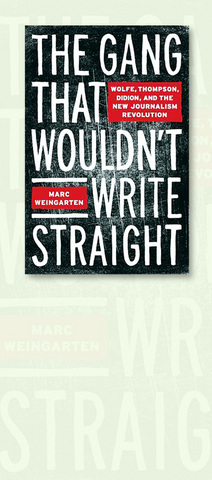In The Gang That Wouldn't Write Straight, his survey of what used to warrant the name New Journalism, Marc Weingarten demonstrates two things clearly. The first: There is no substitute for reading the classics of this genre firsthand. The second: The writers who are commonly lumped together in this category didn't have that much in common after all.
"Was it a movement?"
Weingarten asks about the explosion of dramatically personal nonfiction that arose in the 1960s and broke all the old rules. No, it wasn't. These weren't the Beats or the Abstract Expressionists, and they weren't even terribly collegial. Their respective bodies of work did not really intersect.

But this book's heavy hitters -- Tom Wolfe, Joan Didion, Jimmy Breslin (author of The Gang That Couldn't Shoot Straight), Gay Talese, John Sack, Michael Herr, Hunter S. Thompson and, to some degree, Norman Mailer -- shared an awareness that ordinary reporting was not adequate to the turbulence of either popular culture or politics at that time. And each of them found an exciting, idiosyncratic way to reinvent the nonfiction narrative.
"This is how it all went down," Weingarten writes, with a nod to the era's scorn for plain old punctu-ation; after all, Wolfe was capable of using ":::::" as a figure of speech.
Then Weingarten goes into the Greatest Hits roundup that is this book's main raison d'etre. He examines the making of the period's best-known nonfiction in admiring, sometimes illuminating detail.
So he is with Thompson during his early misadventures with the Hell's Angels, and on the trips, both geographic and psychedelic, that became Fear and Loathing in Las Vegas.
Thompson's "shoot-from-the-hip-flask reporting" makes him a natural, flamboyant favorite in a book like this.
As an editor, Jim Silberman of Random House, once said of Thompson: "Your method of research is to tie yourself to a railroad track when you know a train is coming to it, and see what happens."
Weingarten is also with Wolfe, first with Ken Kesey and his Merry Pranksters and later at Leonard and Felicia Bernstein's fundraiser for the Black Panthers, the party that would live in infamy in Radical Chic. He is with Herr in the Vietnam of Dispatches, and he slouches toward Bethlehem, however briefly, with Didion. (She is the least effectively explored figure here; her work already articulates whatever Weingarten might say about her.) He is with Mailer during the boozy antics that found their way into The Armies of the Night.
A parasitical chronicler could confine himself to piggybacking and just quote abundantly from these neo-Olympians. But Weingarten also makes a serious if not wildly original effort to trace these writers' stylistic innovations. Some of his material comes from interviews with many principals -- including Clay Felker of New York magazine and Jann Wenner of Rolling Stone, whom he deems (along with Harold Hayes of Esquire, who died in 1989 and left an unpublished memoir that is a resource here) the most visionary and laissez-faire editors of their time.
But a lot of the book recapit-ulates the same first-person stories that gave this brand of journalism its terrific immediacy. Readers who know the original writing may yawn at the rehashing and paraphrasing in Weingarten's version.
Still, this book can be regarded as a tour guide's view of Mount Rushmore. It is intelligent hagio-graphy with a moderate interest in the roots, progress and eventual decline of New Journalism's methods.
As he looks to the past, Weingarten cites Jonathan Swift, Charles Dickens, Henry Adams, Jack London and George Orwell as early practitioners of first-person, semi-fictionalized
reportorial writing. Looking forward, he sees both a cheapening of New Journalism tactics into cliche (think of any magazine story with a first-person, present-tense lead to set its scene) and legitimate heirs to the genre's best legacy. Ted Conover (Newjack), Michael Lewis (Moneyball), Adrian Nicole LeBlanc (Random Family), Jon Krakauer (Into Thin Air), Barbara Ehrenreich (Nickel and Dimed), and Susan Orlean (The Orchid Thief) are mentioned as keepers of the flame.
While The Gang That Wouldn't Write Straight admires the pioneering audacity of its central figures, it also weighs the trouble they created. Even while Wolfe was in his early prime, zeroing in on the class striations that would loom so large for New Journalists, there were Wolfe imitators everywhere; the book provides some painful illustrations.
And along with the idea of telling feature stories from the viewpoints of their subjects came an unfortunate eagerness to conflate, exaggerate or just plain make up characters. The book describes how one prominent newspaper editor doubted Breslin's veracity enough to visit a hangout that figured in Breslin's column. The thugs and boozers and mobsters of Breslin's stories were really there, right on their barstools, as advertised.
New Journalism's greatest missteps are right here amid its greatest hits. Consider the repercussions of Breslin's novel but maudlin means of covering the assassination of President Kennedy. ("That's nice soil," a cemetery superintendent told him, when Breslin decided to find the human interest side of the Kennedy gravedigger's story.) Consider the lingering mistrust created by Gail Sheehy's Redpants and Sugarman, the New York magazine series in which Sheehy claimed to be transcribing the precise thoughts of a prostitute but had made up a composite character.
And consider Truman Capote, an earlier New Journalism pioneer, currently depicted on film in Capote as a celebrity sweeping into Kansas in 1959 to research the crime story in tiny Holcomb that would become In Cold Blood. He would indeed become famous for this work, but a degree of exaggeration goes with this territory. At the time, "no one recognized him or his work," Weingarten maintains. "Only two high school teachers had ever read any of his books."
Publication Notes:
The Gang That Wouldn't Write Straight
By Marc Weingarten
325 Pages
Crown

One of the most important gripes that Taiwanese have about the Democratic Progressive Party (DPP) is that it has failed to deliver concretely on higher wages, housing prices and other bread-and-butter issues. The parallel complaint is that the DPP cares only about glamor issues, such as removing markers of Chinese Nationalist Party (KMT) colonialism by renaming them, or what the KMT codes as “de-Sinification.” Once again, as a critical election looms, the DPP is presenting evidence for that charge. The KMT was quick to jump on the recent proposal of the Ministry of the Interior (MOI) to rename roads that symbolize

On the evening of June 1, Control Yuan Secretary-General Lee Chun-yi (李俊俋) apologized and resigned in disgrace. His crime was instructing his driver to use a Control Yuan vehicle to transport his dog to a pet grooming salon. The Control Yuan is the government branch that investigates, audits and impeaches government officials for, among other things, misuse of government funds, so his misuse of a government vehicle was highly inappropriate. If this story were told to anyone living in the golden era of swaggering gangsters, flashy nouveau riche businessmen, and corrupt “black gold” politics of the 1980s and 1990s, they would have laughed.

It was just before 6am on a sunny November morning and I could hardly contain my excitement as I arrived at the wharf where I would catch the boat to one of Penghu’s most difficult-to-access islands, a trip that had been on my list for nearly a decade. Little did I know, my dream would soon be crushed. Unsure about which boat was heading to Huayu (花嶼), I found someone who appeared to be a local and asked if this was the right place to wait. “Oh, the boat to Huayu’s been canceled today,” she told me. I couldn’t believe my ears. Surely,

When Lisa, 20, laces into her ultra-high heels for her shift at a strip club in Ukraine’s Kharkiv, she knows that aside from dancing, she will have to comfort traumatized soldiers. Since Russia’s 2022 invasion, exhausted troops are the main clientele of the Flash Dancers club in the center of the northeastern city, just 20 kilometers from Russian forces. For some customers, it provides an “escape” from the war, said Valerya Zavatska — a 25-year-old law graduate who runs the club with her mother, an ex-dancer. But many are not there just for the show. They “want to talk about what hurts,” she